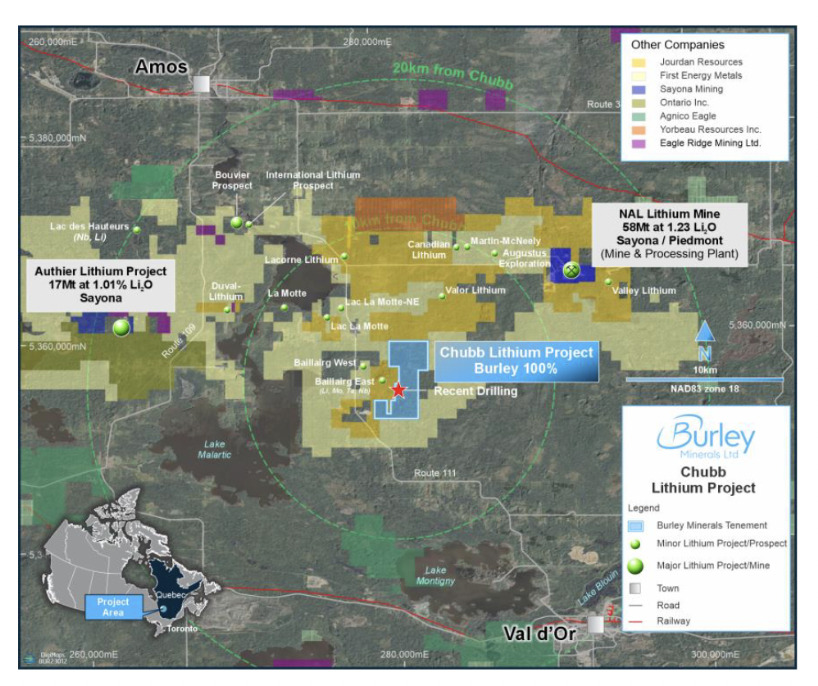Burley’s Chubb confirms ‘highly evolved’ LCT pegmatite with high-grade caesium and lithium assay results

2024, a Pollucite Odyssey: Burley’s Chubb lithium project has delivered exciting new results. Pic via Getty Images
- Burley’s Chubb project in Quebec has delivered a strong set of assay results confirming prior visual estimates of pollucite mineralisation.
- High-grade lithium was expected, but ‘high-grade caesium-bearing mineral pollucite has also piqued company interest.
- Significant pollucite mineralisation in LCT pegmatites are said to be a rarity
Special Report: Burley Minerals, primarily on the hunt for lithium in Canadian hotspots Quebec and Manitoba, has not only confirmed high-grade spodumene at its Chubb project, but a high-value pollucite find to boot.
If Burley Minerals (ASX: BUR) was very pleasantly surprised (and it was) to make a recent chance find of pollucite at its highly prospective Chubb lithium project in Quebec, it has strong reason this week to allocate more of the company’s resources and attention.
A double whammy of assay results from Chubb, for both lithium and caesium, has just come back from the lab, and the figures (see further below) have excited the company.
If you’re wondering what on/in earth pollucite is, then fair enough.
It’s the premium caesium-bearing mineral, classified as critical by the USA and Canada.
Caesium’s primary use is as a specialty additive to fluid used in high-pressure, high-temperature, oil-well drilling and, pollucite is regarded as something of a rarity in economic deposits.
As Burley MD and CEO Stewart McCallion told Stockhead recently, “there are no mines currently producing pollucite” with recent reports suggesting that pure caesium was being sold at nearly US$98/gram.
“That’s 50% more than the current gold price,” McCallion noted.
The Chubb project, by the way, is close to Canada’s only operating lithium mine, the 58Mt @ 1.23% Li2O North America Lithium (NAL) operation jointly run by Sayona Mining (ASX:SYA) and Piedmont Lithium (ASX:PLL).

Double take – BUR’s latest assay results
The company’s latest assay data has confirmed what it describes as high-value, highly evolved, LCT pegmatite with pollucite and high-grade spodumene intersections within the southern extent of the spodumene bearing Main Dyke at Chubb.
The strike is at least 60m of strong pollucite mineralisation, which is still open down plunge.
The now-confirmed pollucite results were intersected in holes CLP-038 and CLP-063 with the former previously reporting: 2.8m at 6.8% Cs2O (caesium oxide) in high-grade pollucite and 5.3m at 2.3% Li2O including 2.3m at 3.9% Li2O in spodumene.
Meanwhile, assay results from hole CLP-063 confirm earlier visual estimates of 11m at 1.7% Li2O in high-grade spodumene, and 4m at 2.4% Cs2O including 2m at 4.2% in high grade pollucite intersected within the spodumene zone.

‘Very highly evolved’
According to the company, the presence of both spodumene and pollucite in the same zone reflects a very evolved LCT pegmatite.
“Burley Minerals are thrilled to discover this premium pollucite zone in the Main Dyke at Chubb Central, where we have already defined significant and continuous spodumene mineralisation,” McCallion said of the additional new pollucite finds.
“The pollucite mineralisation confirms a very highly evolved, high value, LCT pegmatite system at Chubb Central Mineralised Zone.
“Significant discoveries of pollucite in LCT pegmatites are very rare and only three pollucite mines have operated in recent times – Tanco Mine (Manitoba), Sinclair Mine (Western Australia) and Bikita Mine (Zimbabwe).
“Pollucite has only been found in significant amounts in large, highly differentiated and evolved Lithium Caesium Tantalum pegmatite systems which bodes well for the prospectivity of the Chubb Project for further discoveries of LCT-related minerals.”
This article was developed in collaboration with Burley Minerals, a Stockhead advertiser at the time of publishing.
This article does not constitute financial product advice. You should consider obtaining independent advice before making any financial decisions.
Related Topics

UNLOCK INSIGHTS
Discover the untold stories of emerging ASX stocks.
Daily news and expert analysis, it's free to subscribe.
By proceeding, you confirm you understand that we handle personal information in accordance with our Privacy Policy.








